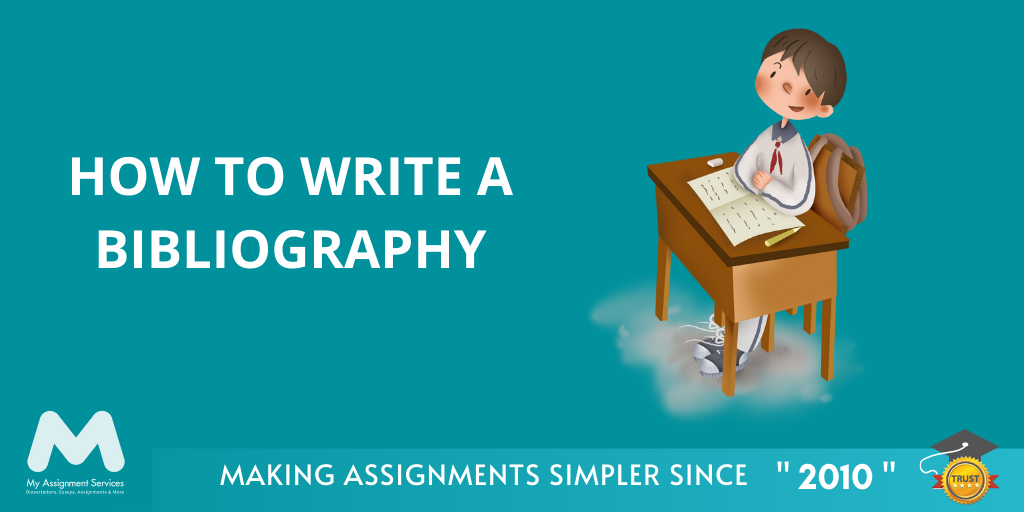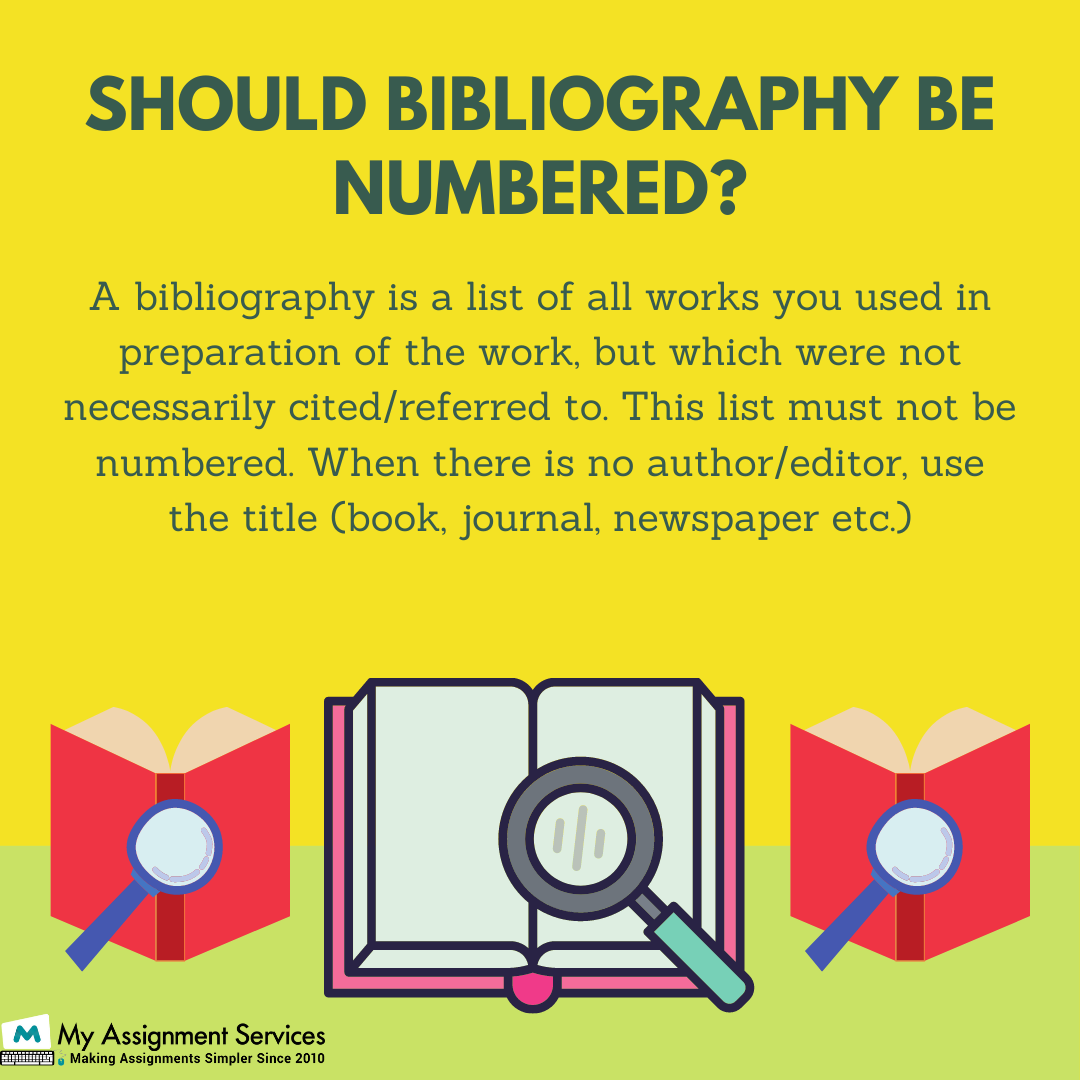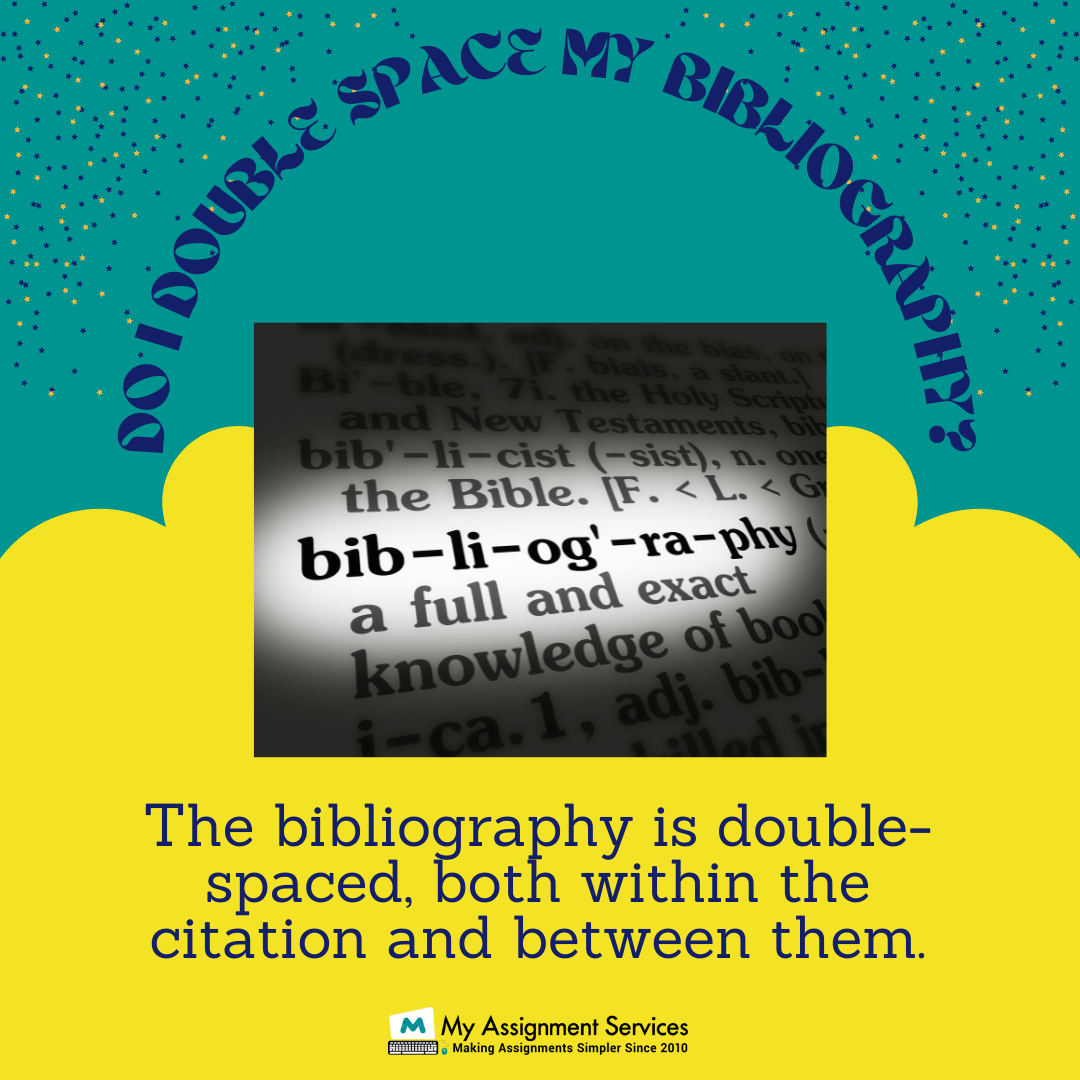
A bibliography is an alphabetized list of sources that you have cited in your research paper. Your instructor might give you a specific format to use for your bibliography, or she may say to list the sources "in the style of" so-and-so's text.
Whenever possible, it is best to consult with your instructor about what should be included in each source entry because different instructors will want different things. If there are exceptional circumstances that prevented or limited access to some materials, let her know before she reads over what you've written.

The items listed in your bibliography should be carefully chosen by you and depend upon the type of writing and research project you're doing. Along with the sources themselves, your bibliography lists your reasons for using those materials and what you will use them for in your paper. If done correctly, this process can save you time and effort as well as improve the quality of your work.
You as a writer have several tasks when it comes to evaluating and including material:
Think of your bibliography as a tool available to anyone who wants to check up on any aspect of your work, whether they're fellow students or professors, librarians, researchers in other disciplines, even potential employers. It is important that everything be accurately documented so that people interested in your work can follow it precisely, with no mistakes or ambiguities.
Include only published sources, not things like newspaper articles from microfilm, class handouts from university extension courses, listserv postings, or e-mails between friends about a book or movie, or website. If you've consulted something that isn't a conventional publication but is still important to your research, you can include it in an appendix (some instructors will want you to do this).
Someone's personal website or listserv posting might contain very valuable information, but because the author is not a published expert in his field, his work cannot be considered scholarly. Even though there may be other material out there about the idea he espouses on his site, if he has not himself written anything that will be accepted by others who study that subject, then you cannot cite him. It is even more difficult to verify facts from non-academic websites and emails because anyone can post anything they like online without any consequence for being wrong. So unless you know beyond a doubt that a reliable source writes a website or e-mail message, you cannot use it even if it contains exactly the information you need.
This means that when you get to the part of your paper where you have to include work from a certain author, you should find all of his published material from the time period in which your project takes place. If there's no more than one book available, don't choose a specific chapter and only quote from that; instead, summarize what he says and list page numbers for specific passages. Sometimes an article will be enough for your purposes but if not, try to locate other pieces by this same author who can provide different points of view on the topic. All quotations and references you use should be listed in your bibliography (see below) and footnotes (in-text citations).

Be sure to include information that will help others locate the source later on. You can do this by including as much of the following as possible: author's full name, the title of work, place of publication (if not already obvious), publisher (if not part of a larger publishing company like Random House or Houghton Mifflin), date if available, pages consulted. Suppose it is a chapter from a larger book. In that case, you might include page numbers instead if it is an article from a magazine or journal, list volume number and issue date(s), and the page number (you might also include a page number if you only consulted the article online). If it is an e-mail or website, use paragraph numbers and/or chapter or section titles (if available) in addition to the author, title of work, URL (web address).
This means double-checking every source to make sure that the name of the author, book, film, or journal is spelled correctly; that titles are exactly as listed in your sources; and even using footnotes when necessary to make it clear where one source ends, and another begins. It's much better to be fussy about these things right at the beginning than to have readers lose track of which author you're citing in which work.
This means that if you use just one statistic or quote from a certain book, even though it may only be three sentences long and you might think it's okay not to include page numbers for something so short, in fact, it is still necessary because your reader needs to know where this information comes from and whether the rest of the text substantiates your point.
It used to be that people were very wary about putting their names on the internet, but these days there are many cases where an author will post his research without any control over other people's responses to it later on—and sometimes these other responders do not only disagree with what the first author claims (which is expected and healthy), but will then post it on a website where everyone can see their different opinions. This can be confusing for anyone who might later try to check out the debate, so it's important not to cite material from websites where you don't know who wrote it; instead, try to find as many books as possible by people you do trust.
Copyright laws require that if you use more than small bits of someone else's work in your own project, you must make those bits available under similar terms. This means that if any part of your paper uses quotations or ideas that are copyrighted and available only through a particular publishing company, you will need to buy your own copy of the book and cite page numbers or information that is not available electronically.
These are resources such as biography webpages on alzheimers.org, documentaries, articles from magazines like "Psychology Today" about how to find a therapist, and so on. While some secondary books can be extremely useful (in particular, they often contain long lists of bibliographical citations), it's important to remember that these works depend on their authority on what other people have written before them—which means that if the original author is wrong, then the secondary citation might be wrong too! So even though secondary citations can save you time by pointing you toward good sources in the first place, make sure you don't take their word for anything without checking it out for yourself.
There are three common kinds used in psychology papers: APA form, MLA form, and Chicago style. Make sure that whatever guide your teacher gives you makes sense to you—and be aware that she may have adapted this standard format to suit her own needs!
Save every piece of writing advice you receive, including this one! One way that deciding what citations to include helps is by helping writers figure out how much detail they need about any material they read or heard about.
Author last name, first name. Title of book. Place of publication: Publisher, Year of publication. Book with multiple authors
Author #1 last name, first name; Author #2 last name, first name; Book title. Place of Publication: Publisher, Year.
Editor Forename Surname (if known); Editor Last name, first name. "Title of book ". Place of Publication: Publisher, Year.
Edited Book with an Editor who is also the author
Editor Forename Surname (if known); Editor Last name, first name; Author(s) First initial Surname (if any). "Title of Book ". Place of Publication: Publisher, Year.
Author Forename Surname (if known); Author Initials Surname (if any). "Title of article". Place of Publication: Publisher, Date. In Editor Forename Surname (ed.) Title of Book. Place of publication: Publisher, date, page range from #1 to #.#.
Author Forename Surname (if known); Author Initials Surname (if any). "Title of article". Name of Journal, volume number(issue number), Month and Year, pages from #1 to #.#. Accessed Day Month Year
Author Forename Surname (if known); Author Initials Surname (if any). "Title of article". Name of newspaper, date, and day month year. Accessed Day Month Year
Name of author Forename Surname (if known); Author Initials Surname (if any). "Title of article". Name of Website, date Day Month Year
Author Forename Surname (if known); Author Initials Surname (if any). Editor Forename Surname (if known); Editor Initials. Title of Book. Place of Publication: Publisher, Year.Books with multiple authors under one editor
Author Forename Surname (if known); Author Initials Surname (if any). Editor Forename Surname (if known); Editor Initials. "Title of book ". Place of Publication: Publisher, Year. Books containing a contribution from a journal article
Author Forename Surname (if known); Author Initials Surname (if any). "Title of article". Name of Journal, Volume Number(Issue Number), Year. Accessed Day Month Year
Having references makes articles informative. It helps the reader know the sources used by you for your article, thereby helping them learn more about the topic. It also makes the article more credible as it gets a reputation to have good references. Our goal is to help students and professionals improve their writing and citation skills through our extensive collection. We are here to provide you withacademic writing help. Now, get all your issues related to referencing and bibliography resolved within minutes through live sessions with experts at My Assignment Services. Send us your query through our web form and we will connect you with one of the leading experts from the industry.

Meet Ian, your trusted homework help expert. With a wealth of experience and a passion for education, Ian specializes in providing personalized support to students. From clarifying concepts to guiding assignments, Ian is dedicated to empowering students to succeed academically. With Ian, achieving your academic goals has never been easier.
1,212,718Orders
4.9/5Rating
5,063Experts
Turnitin Report
$10.00Proofreading and Editing
$9.00Per PageConsultation with Expert
$35.00Per HourLive Session 1-on-1
$40.00Per 30 min.Quality Check
$25.00Total
FreeGet
500 Words Free
on your assignment today
Trending now
The Student Corner
Subscribe to get updates, offers and assignment tips right in your inbox.
Popular Posts
Popular Posts
Request Callback
Doing your Assignment with our resources is simple, take Expert assistance to ensure HD Grades. Here you Go....
Speak directly with a qualified subject expert.
Get clarity on your assignment, structure, and next steps.
In this free session, you can:
Loved reading this Blog? Share your valuable thoughts in the comment section.
Add comment